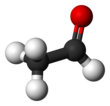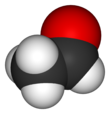
A | B | C | D | E | F | G | H | CH | I | J | K | L | M | N | O | P | Q | R | S | T | U | V | W | X | Y | Z | 0 | 1 | 2 | 3 | 4 | 5 | 6 | 7 | 8 | 9
| |||
| |||
| Names | |||
|---|---|---|---|
| Preferred IUPAC name
Acetaldehyde[3] | |||
| Systematic IUPAC name
Ethanal[3] | |||
| Other names | |||
| Identifiers | |||
3D model (JSmol)
|
|||
| ChEBI | |||
| ChEMBL | |||
| ChemSpider | |||
| ECHA InfoCard | 100.000.761 | ||
| EC Number |
| ||
| KEGG | |||
PubChem CID
|
|||
| RTECS number |
| ||
| UNII | |||
CompTox Dashboard (EPA)
|
|||
| |||
| |||
| Properties | |||
| C2H4O | |||
| Molar mass | 44.053 g·mol−1 | ||
| Appearance | Colourless gas or liquid | ||
| Odor | Ethereal | ||
| Density | 0.784 g·cm−3 (20 °C)[4]
0.7904–0.7928 g·cm−3 (10 °C)[4] | ||
| Melting point | −123.37 °C (−190.07 °F; 149.78 K) | ||
| Boiling point | 20.2 °C (68.4 °F; 293.3 K) | ||
| miscible | |||
| Solubility | miscible with ethanol, ether, benzene, toluene, xylene, turpentine, acetone slightly soluble in chloroform | ||
| log P | -0.34 | ||
| Vapor pressure | 740 mmHg (20 °C)[5] | ||
| Acidity (pKa) | 13.57 (25 °C, H2O)[6] | ||
| -.5153−6 cm3/g | |||
Refractive index (nD)
|
1.3316 | ||
| Viscosity | 0.21 mPa-s at 20 °C (0.253 mPa-s at 9.5 °C)[7] | ||
| Structure | |||
| trigonal planar (sp2) at C1 tetrahedral (sp3) at C2 | |||
| 2.7 D | |||
| Thermochemistry[8] | |||
Heat capacity (C)
|
89 J·mol−1·K−1 | ||
Std molar
entropy (S⦵298) |
160.2 J·mol−1·K−1 | ||
Std enthalpy of
formation (ΔfH⦵298) |
−192.2 kJ·mol−1 | ||
Gibbs free energy (ΔfG⦵)
|
-127.6 kJ·mol−1 | ||
| Related compounds | |||
Related aldehydes
|
Formaldehyde Propionaldehyde | ||
Related compounds
|
Ethylene oxide | ||
| Hazards | |||
| Occupational safety and health (OHS/OSH): | |||
Main hazards
|
potential occupational carcinogen[10] | ||
| GHS labelling: | |||
   [9] [9]
| |||
| H224, H319, H335, H351[9] | |||
| P210, P261, P281, P305+P351+P338[9] | |||
| NFPA 704 (fire diamond) | |||
| Flash point | −39.00 °C; −38.20 °F; 234.15 K | ||
| 175.00 °C; 347.00 °F; 448.15 K[5] | |||
| Explosive limits | 4.0–60% | ||
| Lethal dose or concentration (LD, LC): | |||
LD50 (median dose)
|
1930 mg/kg (rat, oral) | ||
LC50 (median concentration)
|
13,000 ppm (rat), 17,000 ppm (hamster), 20,000 ppm (rat)[10] | ||
| NIOSH (US health exposure limits): | |||
PEL (Permissible)
|
200 ppm (360 mg/m3)[5] | ||
IDLH (Immediate danger)
|
2000 ppm[5][10] | ||
| Safety data sheet (SDS) | HMDB | ||
| Supplementary data page | |||
| Acetaldehyde (data page) | |||
Except where otherwise noted, data are given for materials in their standard state (at 25 °C , 100 kPa).
| |||
Acetaldehyde (IUPAC systematic name ethanal) is an organic chemical compound with the formula CH3 CHO, sometimes abbreviated as MeCHO. It is a colorless liquid or gas, boiling near room temperature. It is one of the most important aldehydes, occurring widely in nature and being produced on a large scale in industry. Acetaldehyde occurs naturally in coffee, bread, and ripe fruit,[11] and is produced by plants. It is also produced by the partial oxidation of ethanol by the liver enzyme alcohol dehydrogenase and is a contributing cause of hangover after alcohol consumption. Pathways of exposure include air, water, land, or groundwater, as well as drink and smoke.[12] Consumption of disulfiram inhibits acetaldehyde dehydrogenase, the enzyme responsible for the metabolism of acetaldehyde, thereby causing it to build up in the body.
The International Agency for Research on Cancer (IARC) has listed acetaldehyde as a Group 1 carcinogen.[13] Acetaldehyde is "one of the most frequently found air toxins with cancer risk greater than one in a million".[14]
History
Acetaldehyde was first observed by the Swedish pharmacist/chemist Carl Wilhelm Scheele (1774);[15] it was then investigated by the French chemists Antoine François, comte de Fourcroy and Louis Nicolas Vauquelin (1800),[16] and the German chemists Johann Wolfgang Döbereiner (1821, 1822, 1832)[17] and Justus von Liebig (1835).[18][19] In 1835, Liebig named it "aldehyde";[20] the name was later altered to "acetaldehyde".[21]
Production
In 2003, global production was about 1 million tonnes.[citation needed] Before 1962, ethanol and acetylene were the major sources of acetaldehyde. Since then, ethylene is the dominant feedstock.[22]
The main method of production is the oxidation of ethene by the Wacker process, which involves oxidation of ethene using a homogeneous palladium/copper catalyst system:
In the 1970s, the world capacity of the Wacker-Hoechst direct oxidation process exceeded 2 million tonnes annually.
Smaller quantities can be prepared by the partial oxidation of ethanol in an exothermic reaction. This process typically is conducted over a silver catalyst at about 500–650 °C.[22]
Antropológia
Aplikované vedy
Bibliometria
Dejiny vedy
Encyklopédie
Filozofia vedy
Forenzné vedy
Humanitné vedy
Knižničná veda
Kryogenika
Kryptológia
Kulturológia
Literárna veda
Medzidisciplinárne oblasti
Metódy kvantitatívnej analýzy
Metavedy
Metodika
Text je dostupný za podmienok Creative
Commons Attribution/Share-Alike License 3.0 Unported; prípadne za ďalších
podmienok.
Podrobnejšie informácie nájdete na stránke Podmienky
použitia.
www.astronomia.sk | www.biologia.sk | www.botanika.sk | www.dejiny.sk | www.economy.sk | www.elektrotechnika.sk | www.estetika.sk | www.farmakologia.sk | www.filozofia.sk | Fyzika | www.futurologia.sk | www.genetika.sk | www.chemia.sk | www.lingvistika.sk | www.politologia.sk | www.psychologia.sk | www.sexuologia.sk | www.sociologia.sk | www.veda.sk I www.zoologia.sk






